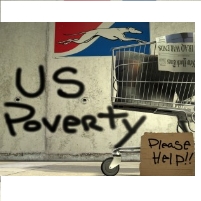Extreme Poverty Neighborhoods Make a Comeback in U.S.
Sunday, November 06, 2011

The number of Americans living in extremely poor neighborhoods increased in recent years, following a period in the 1990s when this problem was declining. Such areas are defined as having 40% of individuals living below the poverty line.
From 2000 to 2009, the number of people living in poverty-stricken neighborhoods went up by about 30%. Overall, the total of poor Americans residing in extreme poverty sections of cities rose from 9.1% to 10.5%, although this is still below the 1990 rate of 14.1%.
According to the Brookings Institution, concentrated poverty nearly doubled last decade in Midwestern cities and increased by one-third in Southern metro areas. Also, the population in extreme-poverty neighborhoods rose more than twice as fast in suburbs as in cities (41% to 17%).
The think tank’s findings were released prior to the U.S. Census Bureau’s plans to unveil next week new measurements for determining who is truly poor. Critics of the existing government metrics have complained that they do not accurately reflect the impact of social welfare benefits or that of taxes, medical care and other costs-of-living factors on the economically disadvantaged.
Forty-five percent of residents of extreme-poverty neighborhoods are African-American and two-thirds ended their education after high school.
-Noel Brinkerhoff
The Re-Emergence of Concentrated Poverty: Metropolitan Trends in the 2000s (by Elizabeth Kneebone, Carey Nadeau and Alan Berube, Brookings Institution) (pdf)
Bleak Portrait of Poverty Is Off the Mark, Experts Say (by Jason DeParle, Robert Gebeloff and Sabrina Tavernise, New York Times)
Reading, Pennsylvania, Leads Nation’s Cities in Poverty Rate (by Noel Brinkerhoff, AllGov)
One Quarter of African-Americans and Latinos Live in Poverty (by Noel Brinkerhoff, AllGov)
- Top Stories
- Unusual News
- Where is the Money Going?
- Controversies
- U.S. and the World
- Appointments and Resignations
- Latest News
- Trump to Stop Deportations If…
- Trump Denounces World Series
- What If China Invaded the United States?
- Donald Trump Has a Mental Health Problem and It Has a Name
- Trump Goes on Renaming Frenzy






Comments